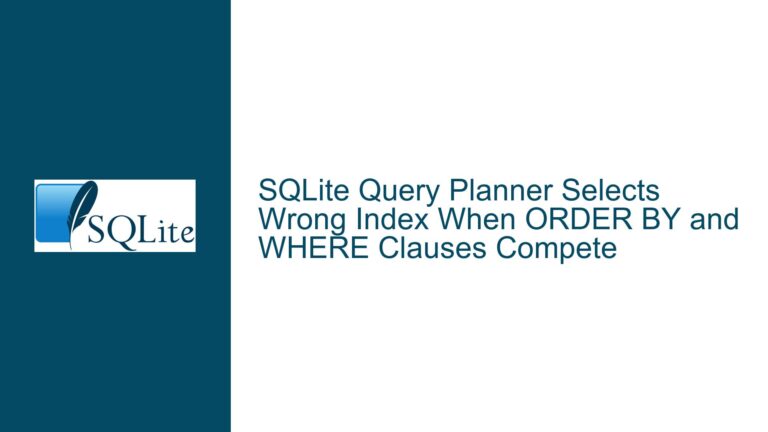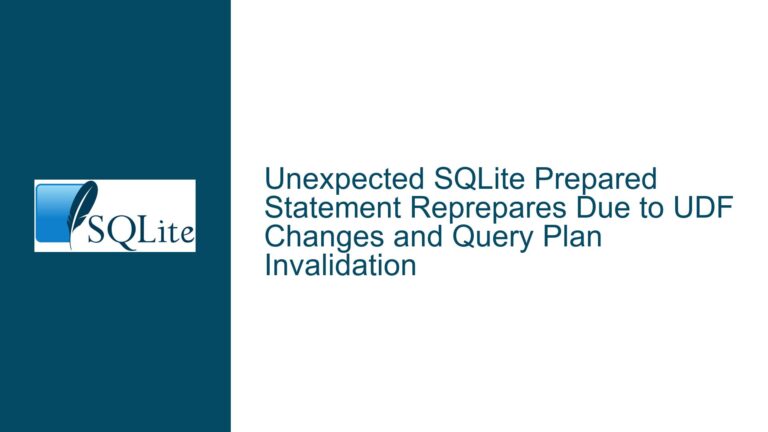Optimizing SQLite Query Planner Behavior with JSON_EACH and Virtual Tables
Understanding the Query Planner’s Cost Estimation with JSON_EACH
The core issue revolves around the SQLite query planner’s behavior when dealing with virtual tables, particularly the JSON_EACH virtual table, and how it estimates costs and row counts during query optimization. The query planner’s decisions are heavily influenced by the cost and row estimates provided by the virtual table’s xBestIndex method. When these estimates are inaccurate or misaligned with the actual data distribution, the query planner may choose suboptimal execution plans, leading to significant performance degradation.
In the case of JSON_EACH, the query planner may repeatedly parse the same JSON string in search of a particular value, especially when there is a usable equality constraint on the value column. This behavior is exacerbated when JSON_EACH is used in complex joins, where the query planner might place the JSON parsing operation in the innermost loop, resulting in excessive computational overhead. The issue is further compounded when custom virtual tables are involved, as their cost estimation logic may not align with the query planner’s expectations, leading to poor plan selection.
Factors Contributing to Poor Query Plan Selection
Several factors contribute to the query planner’s suboptimal behavior in this context. First, the cost estimation logic in the xBestIndex method of virtual tables plays a critical role. If the virtual table reports an excessively high cost for a usable equality constraint on the value column, the query planner may incorrectly prioritize other operations, leading to inefficient query plans. Conversely, if the cost is too low, the query planner may underestimate the computational overhead of parsing JSON strings, resulting in similar inefficiencies.
Second, the interaction between virtual tables and traditional tables can further complicate the query planner’s decision-making process. For example, when a virtual table like JSON_EACH is joined with a traditional table, the query planner must balance the cost of accessing the virtual table with the cost of accessing the traditional table. If the virtual table’s cost estimates are not aligned with the actual data distribution, the query planner may choose to create automatic covering indexes instead of using existing indexes, leading to additional overhead.
Third, the query planner’s reliance on estimated row counts can also lead to suboptimal plans. If the virtual table overestimates or underestimates the number of rows returned by a particular operation, the query planner may make incorrect assumptions about the overall cost of the query. This is particularly problematic when dealing with large datasets, where even small inaccuracies in row estimates can lead to significant performance issues.
Strategies for Improving Query Plan Selection and Performance
To address these issues, several strategies can be employed to improve the query planner’s behavior and overall query performance. First, it is essential to carefully calibrate the cost and row estimates provided by the virtual table’s xBestIndex method. This involves understanding the computational overhead of parsing JSON strings and ensuring that the cost estimates accurately reflect this overhead. For example, if a usable equality constraint on the value column is present, the cost estimate should be high enough to discourage the query planner from placing the JSON parsing operation in the innermost loop.
Second, it is crucial to ensure that the virtual table’s cost estimates are consistent with the query planner’s expectations. This may involve experimenting with different cost values and observing their impact on query performance. For instance, setting a high cost for operations that involve parsing JSON strings while keeping the row estimates low can encourage the query planner to prioritize other operations, leading to more efficient query plans.
Third, when dealing with complex queries involving both virtual and traditional tables, it is important to carefully analyze the query plan and identify potential bottlenecks. This may involve using tools like .wheretrace to gain insights into the query planner’s decision-making process and identify areas where cost estimates may be misaligned. Additionally, creating appropriate indexes on traditional tables can help the query planner make better decisions, especially when dealing with large datasets.
Finally, it is important to consider the impact of automatic covering indexes on query performance. While these indexes can improve performance in some cases, they can also introduce additional overhead, especially when they are created repeatedly during query execution. To mitigate this, it may be necessary to manually create covering indexes that align with the query’s access patterns, ensuring that the query planner can make optimal use of existing indexes.
In conclusion, optimizing the query planner’s behavior with JSON_EACH and virtual tables requires a deep understanding of the cost estimation process and careful calibration of cost and row estimates. By aligning these estimates with the query planner’s expectations and analyzing query plans for potential bottlenecks, it is possible to significantly improve query performance and avoid the pitfalls associated with suboptimal plan selection.






